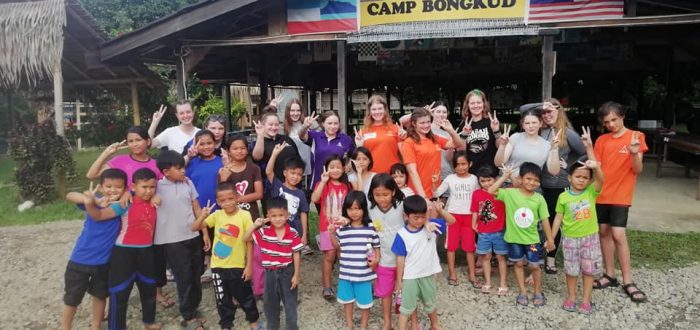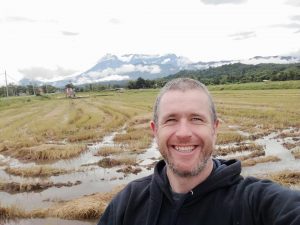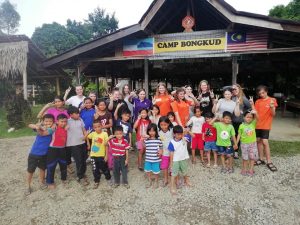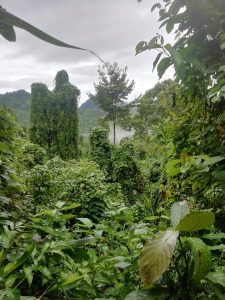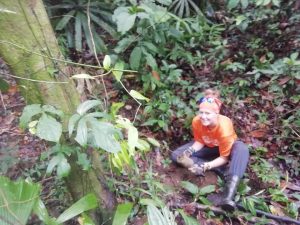
Borneo, the very name has an air of exoticism, a sense of the wild and unexplored. When I was a kid and looking even more unkempt than usual my Dad used to describe me as looking like “the wild man of Borneo” and it is a place of wild, remote valleys, unique wildlife and, sadly, in recent times the controversy over the plantations of Palm Oil. I was fortunate enough to be offered the chance to lead a three week expedition with Cranbourne School from Melbourne and then tag on an extra week of holiday at the end of it for further adventuring! I had visited once before for a week with a team from Dubai but this trip gave me a chance to see a lot more of the country and fully immerse myself in this wild and wonderful land.
The team arrived into Kota Kinabalu, he very pleasant capital of the Sabah region, in the middle of the night and after a night of kip at Borneo Backpackers () we headed North to our camp at Tinangol, a small village close to the very top tip of Borneo. It was a beautiful, rural camp surrounded by Rubber trees and jungle and a 45 minute walk from the heart of the village where we would be doing our project work. I’d read that Borneo only has two seasons, the wet season and the “less wet” season, we definitely arrived in the former and experienced some phenomenal downpours in the early afternoon and overnight, but our longhouses stayed watertight and we managed to time our walks to beat the worst of it. The team worked on cementing projects at the community centre and played a lot of “duck,duck,goose” with the local kids. We learned a lot about the longhouses which can host 500 members of the same extended family and we listened to the local kids practicing their Christmas carols (the majority of indigenous people in Borneo are Christian although Malaysia is a predominantly Muslim country). We saw the fake caves the local people built in order to try and trick the Swiftlets whose nests make Bird’s Nest Soup into nesting and visited the Sumangkap Gong Making Village. It was a great introduction to the island and whetted the appetite for the rest of our adventure.
We were sad to leave Tinangol but headed down tour second camp in the village of Bongkud which has a great view of Borneo’s mighty mountain Gunung Kinabalu. Unlike Tinangol the camp is in the heart of the village and only a short walk from our projects. We helped with maintenance at the primary school and worked on clearing and installing a cement drainage channel to help try and deal with the frequent deluges that swamped the roads! We learned the local Dusan language, made bead jewellery, practiced the infamous Bamboo dance, baked Banana Bread, ran English lessons for the local children and, as preparation for our trek, undertook a (very) early morning ascent of Bongkud Hills for some beautiful views of rolling hills, jungle and cloud inversions! The trek itself was a four and a half day jungle adventure in the Ranau district and proved to be a challenging yet rewarding adventure for the whole team. Borneo is the greenest place I have ever been and the jungle here is dense and buzzing (literally) with life. There were bugs galore, a few Leeches, the odd snake and Ants the size of small dogs ;-), the paths were steep and slippery and there were river crossings, rope climbs and stunning viewpoints where all you could see was jungle. We slept in hammocks, bathed in the river, cooked rice in bamboo, drunk fresh coconut water and fell asleep to the sounds of the jungle. We had an amazing team of guides who looked after us and showed us how the local people used to trap jungle animals. It was a true challenge for the team and they excelled and really pushed themselves earning their afternoon at the Poring Hot Springs which we had on our return to civilisation. However, we weren’t done with the jungle just yet! Our last camp experience was at Batu Puteh on the shores of the Kinabatangan River where we were working on a tree planting initiative with local co-operative group KOPEL. On our boat journeys up the swollen, murky brown river we saw Long Tailed Macaques, Proboscis Monkeys, Hornbills, Eagles and Kingfishers. We planted trees in the face of ferocious Mosquito attacks and saw Scorpions and Frogs on a jungle night walk before heading out of the jungle and over to Borneo’s most famous wildlife experience in Sepilok.
Orang Utans are Borneo’s most famous residents and at the rehabilitation centre in Sepilok you get the chance to see them in the (semi) wild and also in the rehabilitation centre. It’s quite magical. Whilst it’s hard to describe the hairy, orange beasts as beautiful, the experience of seeing them swinging through the trees is just that. The movements, facial expressions and thought processes leave you in no doubt that they are very, very close relatives and it feels like a genuine privilege to be invited into their lives even for an hour or two. In addition to the apes we also got the chance to visit the Sun Bear conservatory where the world’s smallest bears, who unfortunately are sought after for the illegal Far Eastern medicine trade, can live in safety and freedom. There is something Winnie the Pooh like about these beautiful creatures and we were treated to great views of them climbing trees and foraging for food. Our last activity on our last morning was a visit to the War memorial park in Sandakan, sited on the prison camp which was the start of the infamous and horrific Sandakan Death Marches which led to the death of thousands of, mainly, ANZAC prisoners. It was very moving visiting with an Australian team and a fitting last activity for the team to undertake.
Sad as I was to see my Aussie team depart, it was wonderful to have Thalia waiting for me in KK the next morning! We spent a lovely day in KK heading up to the viewpoint at Signal Hill and the Atkinson Clock Tower, one of the oldest buildings in the town. It’s a town with a lovely, relaxed feel and we had a great wander round the night market in Chinatown before an early night. Our first mission was Gunung Kinabalu, the 4095m mountain that towers above everything else on the island. From the moment we left the Timpohon Gate with our guide, Ros, and walking companion, Mr Park from South Korea, the rain started to fall…..and it continued to fall for the vast majority of the next six hours as we slogged up steep stairs, muddy slopes and through thick jungle to the Laban Rata Guest House, our goal for the first day. Laban Rata is at 3272m and surprisingly nice, I had visions of some of the ropier Nepalese tea houses but the guesthouse here was very civilised with comfortable rooms, good grub and a balcony with stunning cloudscape views as the sun set. We were in bed by 8pm and up at 01.30 to the depressing sound of falling rain. If the rain is too severe then the summit gets closed but by 03.00am it had stopped and we were off. Sadly, after just a few minutes Thalia decided that the exertions of the day before had hurt her hamstring and knees so badly and she made the very tough, but mature, decision to turn back to the guest house and leave me to carry on with my summit assault. It was very tough, it was dark and cold, the rock was slippery but I kept at it and just after 05.30am I was one of the first people on Low’s Peak, the highest point on the brutal, shattered, granite peak! It truly is a desolate peak but as I started to descend the other peaks around me loomed out of the gloaming and the views below glowed red as the sun rose, I passed many people still on their way up and Thalia and I were having a huge breakfast a couple of hours later. The descent was knee crunching and as wet as the ascent, Kinabalu is certainly up there with one of the more physically challenging peaks I have done, but the feeling of achievement (for both of us) as we finally reached the gates after passing Carson’s Falls once more was unbelievable. A well deserved day of RNR in Kota Kinabalu was next before we headed off to the interior with Orou Sapulot ( a company I cannot recommend highly enough, they were superb. We drove across the Crocker Range to the town of Keningau where we were picked up by our guides who drove us deeper South into the interior and towards the border with the Indonesian province of Kalimantan. Every mile felt more and more remote as the roads narrowed and got worse and the trappings of civilisation became fewer. A fifteen minute boat ride from Labang Village and we were at the fantastic Pungiton Cave Camp, a beautiful spot on the river bank and at the edge of the jungle. Orou Sapulot is a community based tourism project set up by the Murut people and using the remarkable natural resources found on their land as a source of income to reinvest in opportunities for the local villages and protect the natural environment. The caves are wondrous, they span fifteen separate levels and in the ninety minutes we spent exploring we saw a tiny fraction of them but it was breathtaking. In addition to the enormous caverns, the stalactites and mites and the miles of tunnels we saw giant spiders and millipedes, hundreds of thousands of bats, Swiftlets and a venomous Racer snake. It was the kind of place you visit and say “Why isn’t this a world famous attraction?”, but I am very glad it isn’t and hope it remains a wonderful secret. We feasted on Wild Boar and Venison and fell asleep to the sound of rain drumming on our shelter and the chirping of the ever present Cicada. Day two proved an even greater challenge. Another boat ride took us into the Leechy jungle surrounding the limestone pinnacle of Batu Punggul a 300m limestone outcrop rising out of the rainforest and available to “free climb”, a challenge that proved to be demanding, exhilarating and terrifying in equal measure. It was epic and felt genuinely adventurous and the feeling of achievement on reaching the summit, high above the canopy, was immense. The downclimb felt equally sketchy but we made it to the bottom in one piece and were rewarded with a picnic of fried chicken and watermelon on the banks of the river! We carried on to the guesthouse run by the organisation where we were treated to more delicious Wild Boar before an evening of Rice Wine and some very impressive dancing from the local Murut children in the longhouse hall of the family who set up the business. It felt refreshingly real and non-touristy and was great to see the children so engaged with their own culture and unembarrassed by it. Our last morning saw us leech dodging once more at Vangkaakon waterfall which we reached after driving through a depressingly large Palm Oil plantation. It was a perfect end to our adventure and the Borneo trip in general, swimming beneath a waterfall with a rainforest canopy above……
Borneo is a wonderful destination. It feels genuinely wild, it’s green and lush, the people are friendly and kind, the food is good, KK is a great city and the wildlife is unique and accessible. It’s a destination we need to cherish and protect and I hope to be back sooner rather than later.
- Ian@comewalkwithmeuk.co.uk
- 07855 648786

